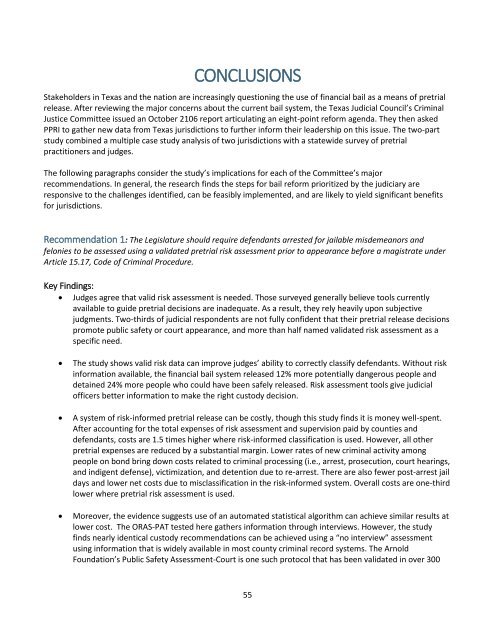LIBERTY AND JUSTICE PRETRIAL PRACTICES IN TEXAS
170308_bond-study-report
170308_bond-study-report
Create successful ePaper yourself
Turn your PDF publications into a flip-book with our unique Google optimized e-Paper software.
CONCLUSIONS<br />
Stakeholders in Texas and the nation are increasingly questioning the use of financial bail as a means of pretrial<br />
release. After reviewing the major concerns about the current bail system, the Texas Judicial Council’s Criminal<br />
Justice Committee issued an October 2106 report articulating an eight-point reform agenda. They then asked<br />
PPRI to gather new data from Texas jurisdictions to further inform their leadership on this issue. The two-part<br />
study combined a multiple case study analysis of two jurisdictions with a statewide survey of pretrial<br />
practitioners and judges.<br />
The following paragraphs consider the study’s implications for each of the Committee’s major<br />
recommendations. In general, the research finds the steps for bail reform prioritized by the judiciary are<br />
responsive to the challenges identified, can be feasibly implemented, and are likely to yield significant benefits<br />
for jurisdictions.<br />
Recommendation 1: The Legislature should require defendants arrested for jailable misdemeanors and<br />
felonies to be assessed using a validated pretrial risk assessment prior to appearance before a magistrate under<br />
Article 15.17, Code of Criminal Procedure.<br />
Key Findings:<br />
Judges agree that valid risk assessment is needed. Those surveyed generally believe tools currently<br />
available to guide pretrial decisions are inadequate. As a result, they rely heavily upon subjective<br />
judgments. Two-thirds of judicial respondents are not fully confident that their pretrial release decisions<br />
promote public safety or court appearance, and more than half named validated risk assessment as a<br />
specific need.<br />
<br />
<br />
<br />
The study shows valid risk data can improve judges’ ability to correctly classify defendants. Without risk<br />
information available, the financial bail system released 12% more potentially dangerous people and<br />
detained 24% more people who could have been safely released. Risk assessment tools give judicial<br />
officers better information to make the right custody decision.<br />
A system of risk-informed pretrial release can be costly, though this study finds it is money well-spent.<br />
After accounting for the total expenses of risk assessment and supervision paid by counties and<br />
defendants, costs are 1.5 times higher where risk-informed classification is used. However, all other<br />
pretrial expenses are reduced by a substantial margin. Lower rates of new criminal activity among<br />
people on bond bring down costs related to criminal processing (i.e., arrest, prosecution, court hearings,<br />
and indigent defense), victimization, and detention due to re-arrest. There are also fewer post-arrest jail<br />
days and lower net costs due to misclassification in the risk-informed system. Overall costs are one-third<br />
lower where pretrial risk assessment is used.<br />
Moreover, the evidence suggests use of an automated statistical algorithm can achieve similar results at<br />
lower cost. The ORAS-PAT tested here gathers information through interviews. However, the study<br />
finds nearly identical custody recommendations can be achieved using a “no interview” assessment<br />
using information that is widely available in most county criminal record systems. The Arnold<br />
Foundation’s Public Safety Assessment-Court is one such protocol that has been validated in over 300<br />
55


